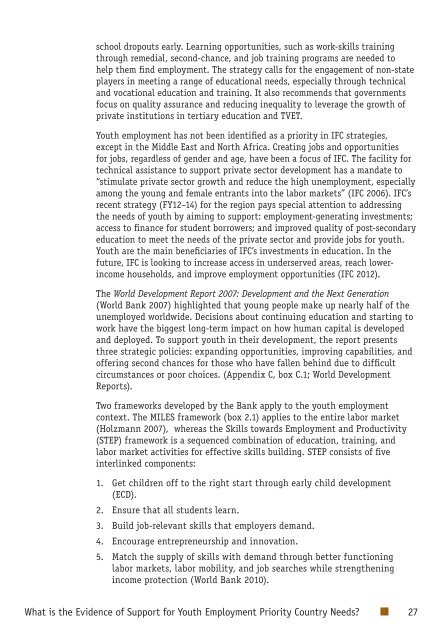Youth Employment Programs - Independent Evaluation Group
Youth Employment Programs - Independent Evaluation Group
Youth Employment Programs - Independent Evaluation Group
Create successful ePaper yourself
Turn your PDF publications into a flip-book with our unique Google optimized e-Paper software.
school dropouts early. Learning opportunities, such as work-skills trainingthrough remedial, second-chance, and job training programs are needed tohelp them find employment. The strategy calls for the engagement of non-stateplayers in meeting a range of educational needs, especially through technicaland vocational education and training. It also recommends that governmentsfocus on quality assurance and reducing inequality to leverage the growth ofprivate institutions in tertiary education and TVET.<strong>Youth</strong> employment has not been identified as a priority in IFC strategies,except in the Middle East and North Africa. Creating jobs and opportunitiesfor jobs, regardless of gender and age, have been a focus of IFC. The facility fortechnical assistance to support private sector development has a mandate to“stimulate private sector growth and reduce the high unemployment, especiallyamong the young and female entrants into the labor markets” (IFC 2006). IFC’srecent strategy (FY12–14) for the region pays special attention to addressingthe needs of youth by aiming to support: employment-generating investments;access to finance for student borrowers; and improved quality of post-secondaryeducation to meet the needs of the private sector and provide jobs for youth.<strong>Youth</strong> are the main beneficiaries of IFC’s investments in education. In thefuture, IFC is looking to increase access in underserved areas, reach lowerincomehouseholds, and improve employment opportunities (IFC 2012).The World Development Report 2007: Development and the Next Generation(World Bank 2007) highlighted that young people make up nearly half of theunemployed worldwide. Decisions about continuing education and starting towork have the biggest long-term impact on how human capital is developedand deployed. To support youth in their development, the report presentsthree strategic policies: expanding opportunities, improving capabilities, andoffering second chances for those who have fallen behind due to difficultcircumstances or poor choices. (Appendix C, box C.1; World DevelopmentReports).Two frameworks developed by the Bank apply to the youth employmentcontext. The MILES framework (box 2.1) applies to the entire labor market(Holzmann 2007), whereas the Skills towards <strong>Employment</strong> and Productivity(STEP) framework is a sequenced combination of education, training, andlabor market activities for effective skills building. STEP consists of fiveinterlinked components:1. Get children off to the right start through early child development(ECD).2. Ensure that all students learn.3. Build job-relevant skills that employers demand.4. Encourage entrepreneurship and innovation.5. Match the supply of skills with demand through better functioninglabor markets, labor mobility, and job searches while strengtheningincome protection (World Bank 2010).What is the Evidence of Support for <strong>Youth</strong> <strong>Employment</strong> Priority Country Needs? 27
















